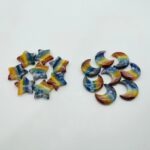Crystals, with their alluring beauty and purported metaphysical properties, have captivated people for centuries. Recognizing crystals accurately is crucial for harnessing their potential and preventing misidentification or fraudulent purchases. This comprehensive guide provides a detailed roadmap to help you identify crystals with confidence.

Key Physical Characteristics:
- Hardness: Measured on the Mohs scale (1-10), hardness indicates a crystal’s resistance to scratching. Common crystals like calcite (hardness 3) are easily scratched, while diamond (hardness 10) is the hardest known natural material.
- Cleavage: The tendency of a crystal to break along specific planes. Crystals with perfect cleavage (e.g., calcite) can be split into flat, smooth surfaces.
- Fracture: Refers to how a crystal breaks when not along cleavage planes. Concoidal fracture (e.g., quartz) results in smooth, curved surfaces, while irregular fracture produces jagged edges.
- Luster: Describes the way a crystal reflects light. Metallic luster (e.g., pyrite) resembles polished metal, while vitreous luster (e.g., quartz) resembles glass.
Optical Properties:
- Color: The most noticeable characteristic, color can vary greatly depending on the mineral’s composition and impurities.
- Streak: The color of a mineral in powdered form. It can differ from the crystal’s original color and aid in identification.
- Diaphaneity: Refers to the transparency of a crystal. Transparent crystals allow light to pass through freely (e.g., clear quartz), while opaque crystals block all light (e.g., galena). Semi-transparent crystals (e.g., smoky quartz) allow partial light transmission.
Crystal Systems:
Based on the arrangement of atoms, crystals belong to seven crystal systems characterized by their shape: cubic, tetragonal, hexagonal, trigonal, orthorhombic, monoclinic, and triclinic. Understanding crystal systems provides valuable clues for identification.
Diagnostic Tests:
- Specific Gravity: A measure of a crystal’s density compared to water. This test requires specialized equipment and is rarely performed in the field.
- Chemical Reactions: Certain chemical reactions can confirm the identity of a crystal. For example, adding hydrochloric acid to calcite produces bubbles of carbon dioxide gas.
- Fluorescence: Some crystals emit light when exposed to ultraviolet radiation. This property can aid in identification, but not all crystals exhibit fluorescence.
Common Mistakes to Avoid:
- Mistaking glass or plastic for crystals. Real crystals have a distinct crystalline structure, while imitations are typically amorphous (without a crystalline structure).
- Confusing different minerals with similar appearances. For example, pyrite and gold may look similar, but their hardness and streak can distinguish them (pyrite is hard and has a black streak, while gold is soft and has a golden streak).
- Relying solely on color for identification. Color can be misleading, as different minerals can have similar colors. Perform additional tests to confirm a crystal’s identity.
FAQs:
- What is the most common crystal? Quartz is the most abundant mineral on Earth.
- How can I learn more about crystals? Attend workshops, read books, or consult online resources.
- What are the most valuable crystals? The value of crystals varies depending on their rarity, quality, and size. Diamonds and rubies are among the most valuable.
- Can crystals heal me? While some crystals are believed to possess healing properties, there is no scientific evidence to support this claim.
New Applications:
The ability to accurately identify crystals opens up a world of potential applications:
- Jewelry and Art: Gem-quality crystals are highly sought after for jewelry and decorative objects.
- Industry: Crystals are used in a wide range of industrial applications, including electronics, optics, and construction.
- Medicine: Certain crystals, like quartz, are used in medical devices to generate ultrasonic waves.
- Technology: Researchers are exploring the use of crystals in advanced technologies such as quantum computing and nanotechnology.
Conclusion:
Recognizing crystals empowers you to appreciate their natural beauty, understand their scientific significance, and harness their potential for various applications. By carefully observing physical characteristics, optical properties, and utilizing diagnostic tests, you can confidently identify crystals and avoid misidentification. Remember, accurate crystal identification is a journey that requires patience, knowledge, and a thirst for exploration.
Table 1: Common Crystal Hardness
| Mineral | Mohs Hardness |
|---|---|
| Talc | 1 |
| Gypsum | 2 |
| Calcite | 3 |
| Fluorite | 4 |
| Apatite | 5 |
| Feldspar | 6 |
| Quartz | 7 |
| Topaz | 8 |
| Corundum | 9 |
| Diamond | 10 |
Table 2: Examples of Cleavage and Fracture
| Mineral | Cleavage | Fracture |
|---|---|---|
| Calcite | Perfect | Irregular |
| Quartz | None | Concoidal |
| Feldspar | Imperfect | Irregular |
| Tourmaline | Poor | Irregular |
| Mica | Perfect | Basal |
Table 3: Crystal Systems and Shape
| Crystal System | Shape |
|---|---|
| Cubic | Regular polyhedron (e.g., cube, octahedron) |
| Tetragonal | Prism or pyramid with square base |
| Hexagonal | Prism or pyramid with hexagonal base |
| Trigonal | Prism or pyramid with triangular base |
| Orthorhombic | Parallelepiped |
| Monoclinic | Inclined parallelepiped |
| Triclinic | No symmetry |
Table 4: Optical Properties of Common Crystals
| Mineral | Color | Diaphaneity | Luster |
|---|---|---|---|
| Amethyst | Purple | Semi-transparent | Vitreous |
| Diamond | Colorless | Transparent | Adamantine |
| Emerald | Green | Transparent | Vitreous |
| Garnet | Red | Transparent | Resinous |
| Opal | White to black | Semi-transparent to opaque | Opalescent |
| Quartz | Clear to colorless | Transparent to semi-transparent | Vitreous |
| Ruby | Red | Transparent | Adamantine |
| Sapphire | Blue | Transparent | Vitreous |




























